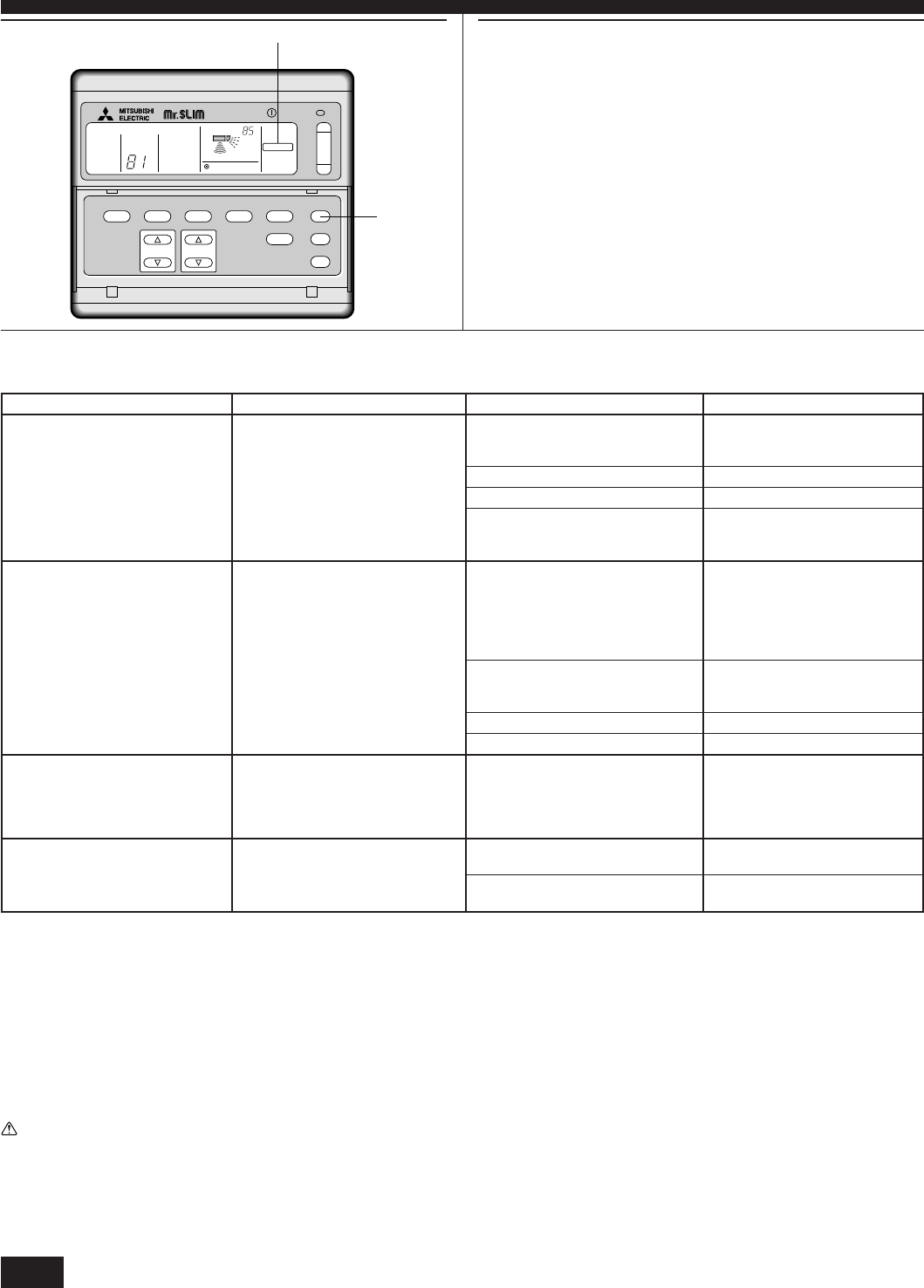
6
4. Troubleshooting
NOTE: After a power cut, the unit will not restart automatically. You will have to restart it by pressing the POWER - ON/OFF button on the remote controller.
Wired remote controllers
In any of the following cases, turn off the main power switch and contact your local dealer for service:
•“CHECK” followed by “P1”, “P2”, “P3”, “P4”, “P5”, “P7” or “CENTRALLY CONTROLLED” is displayed on the control panel.
• The switches do not work properly.
• The circuit breaker trips frequently (or the fuse blows frequently).
• Water has accidentally been splashed into the unit.
• Water leaks from the unit.
• Something is accidentally dropped into the air-conditioner.
• An unusual noise is heard during operation.
Warning:
If the air conditioner operates but does not cool or heat (depending on model) the room, consult your dealer since there may be a refrigerant leak.
Be sure to ask the service representative whether there is refrigerant leakage or not when repairs are carried out.
The refrigerant charged in the air conditioner is safe. Refrigerant normally does not leak, however, if refrigerant gas leaks indoors, and comes into contact with the
fire of a fan heater, space heater, stove, etc., harmful substances will be generated.
Problem
Unit will not start.
Unit discharges air well, but fails to cool
or heat the room well.
Unit does not start immediately.
Unit stops soon after starting.
Cause
Main power switch is turned off.
Main power fuse has blown.
Outdoor unit’s ground fault breaker is open.
A power cut has occurred (see NOTE be-
low).
Improper temperature setting - e.g. you
have selected COOL mode, but the desired
temperature setting is higher than the cur-
rent room temperature.
Filters are clogged.
Outdoor unit’s intake or outlet is obstructed.
A door or window has been left open.
Unit is waiting three minutes before restart-
ing.
Indoor or outdoor unit’s intake or outlet is
obstructed.
Filters are clogged.
Solution
Turn main power on. Then press the
POWER ON/OFF button to turn the unit
on.
Replace the fuse.
Reset the ground fault breaker.
Wait until power is restored, then press
the POWER ON/OFF button to turn the
unit on.
Check the set temperature on the remote
controller and the actual intake air tem-
perature. Use the COOLER and
WARMER buttons to set the temperature
as described in “Selecting a temperature”
on page 3.
Clean the filter and resume operation.
See “Cleaning the filters and the indoor
unit” on page 5.
Remove the obstruction.
Shut door or window.
Wait until the unit restarts automatically.
The compressor may hesitate resuming
because a three-minute resume preven-
tion circuit is incorporated in the outdoor
unit for protection of the compressor.
Remove obstruction and restart the unit.
Remove the obstruction. Clean the filter
and resume operation.
Display reading
Pilot lamp does not turn on even when the
POWER ON/OFF button is pressed.
Remote controller shows that the unit is
operating.
Remote controller shows that the unit is
operating.
Remote controller check display reads
“CHECK P6” or “CHECK P8”.
4. Troubleshooting
Before you call out a repair man, check the following table to see whether there is a simple solution to your problem.
ON/OFF
–
TIMER SETSET TEMP.
REMOTE CONTROLLER
MODE TIMER ON/OFF CLOCK/TIMER FAN SPEED AIR DISCHARGE FILTER
AIR SWEEP CHECK
TEST RUN
STAND BY
DEFROST
DRY COOL
AUTO FAN
HEAT
CENTRALLY CONTROLLED
˚F
SWING
FAN
SPEED
AUTO
RETURN
NOT AVAILABLE
˚F
CHECK MODE
FILTER
TIMER
TEST RUN
TIMER OFF CLOCKAUTO AUTO
CHECKSET TEMP. START STOP
A
1
3.2. Care and cleaning
Clean the filter
When the A “FILTER” indicator blinks on the remote controller to alert you to the
necessity of cleaning of the filter.
∗ As a guideline for typical office environment, the long-life filter must be cleaned
every 2,500 (PL(H))/100 (PC(H), PK(H)) operating hours.
Reset the FILTER indicator
1 Press the FILTER button twice after cleaning.
s When you press the FILTER button twice, the “FILTER” indicator A will be
turned off and reset.
s The FILTER indicator provides you with a guideline for the necessity of
filter cleaning based on total operating hours in typical indoor air condi-
tions. Depending on different operating environments, more or less fre-
quent cleaning may be necessary.
• Not available for wireless remote controller.
3. Care and cleaning














